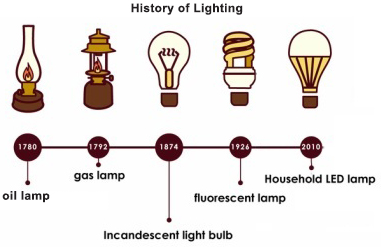EFFICACY AND ITS RELEVANCE IN THE LIGHTING WORLD
 If you look at the history of lighting, it is very obvious that there’s not been much advancement / evolution in this segment from a technology stand point.
If you look at the history of lighting, it is very obvious that there’s not been much advancement / evolution in this segment from a technology stand point.
It’s taken more than 200 years to move from filament / gas based light sources to energy efficient solid state lighting – LEDs.
It’s no wonder then, that over these years, mankind’s understanding of light
(brightness) is directly linked to wattage. More light = More wattage and vice versa.
Till just a few years ago, and even now, while buying a light one only considered the wattage and color of the light.
With the entry of LEDs in the lighting segment, the picture has started changing. LEDs have introduced people to terms such as CCT, CRI, Lumens, Efficacy, Lux, Light Depreciation, etc.
It won’t be wrong if the LED Lighting technology is considered disruptive.
It is therefore important to understand the relevance of EFFICACY in more details.
-
Bullet points for Efficacy Tab:
-
Efficacy means lumens output per watt consumed by Led light.
-
While buying LED lights, select a higher efficacy product & check the total lumens output and not WATT alone.
-
Higher Efficacy = Higher Illumination in the Least Possible Wattage. This leads to High Energy Savings.
How to calculate Efficacy: Total Lumens/Luminous Flux/Lumens
Power (W)
Product A: 400 Lumens/5W = 80 lumens/W
Product B: 500 lumens/5W = 100 lumens/W
This means, while product B consumes the same power as Product A, it’s more efficient as it gives out more light output.
A case study - How a Higher Efficacy Product Saves Cost:
An architect has recommended 48 nos. of 37W panel lights from a competitor’s brand to be used for a shop floor.
The table below has the technical parameters of Samudra’s panel light as well as that offered by competition.

Observations:
-
Using 48 nos. of LED panel lights by Competition, the total lumens that can be achieved = 48 nos. x 2072 Lm = 99,456 Lm. The total cost = 48 nos. x Rs. 3000/- = 1,44,000/-
-
Using Samudra LED panel Lights, to get total lumens of 99,456, only 30 panel lights are required since the total lumens of Samudra LED panel lights is much higher than that of competition. So 30 nos. x 3332 Lm = 99,960 Lm. The total cost = 30 nos. x Rs. 4000/- = 1,20,000/-
-
Moreover, each Samudra LED panel light consumes 3W lesser power than that of the competition. So the energy consumption is also lesser. Hence the customer will be able to achieve higher savings and the ROI will be faster in comparison to the product offered by competition.
-
So while the cost per unit of Samudra’s LED panel light is seemingly higher than that of competition, when one looks at the entire project in totality, the total cost is much lesser by using Samudra LED products and savings achieved are also much higher.
-
The CRI of the product offered by Samudra is much higher and closer to 100, thereby providing close to true color rendition.
-
The PF of Samudra’s panel light is much higher, thereby minimizing power losses/wastage. Electricity supplying companies likes MSEB, BEST, etc. levy penalties if the PF is <0.90.
-
Cost of ownership is the lowest with Samudra LED products.


